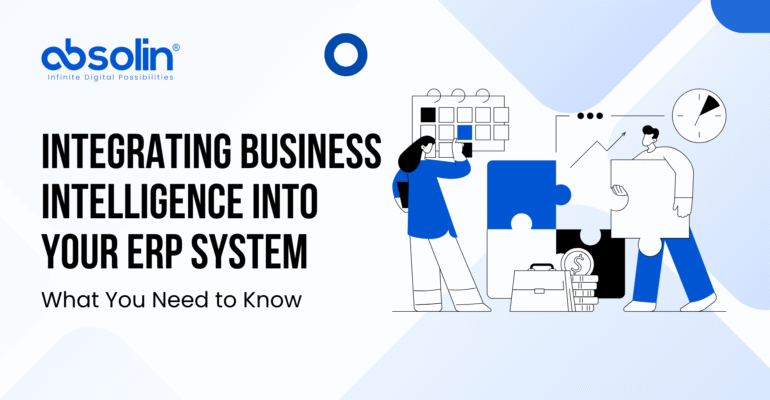Integrating Business Intelligence into Your ERP System: What You Need to Know

Integrating Business Intelligence into Your ERP System: What You Need to Know
When Data Becomes the New Currency of Growth
In today’s business world, data isn’t just a byproduct, it’s the currency of competitiveness. Every sale, every customer interaction, every operational movement creates valuable information. But most companies are sitting on mountains of data locked inside their ERP systems — underused, underanalyzed, and underestimated.
Having data isn’t the same as understanding it. That’s where Business Intelligence (BI) steps in. By integrating BI with your ERP system, you turn static numbers into living insights — real-time dashboards, predictive trends, and performance analytics that tell you why things happen, not just what happened.
It’s the difference between driving by looking in the rearview mirror and navigating with a real-time GPS.
This is your guide to understanding how BI-ERP integration works, why it matters, and how it can transform decision-making across your organization.
1. The Power of Integration: Why ERP Alone Isn’t Enough
ERP systems are incredible for managing operations, from finance and inventory to supply chains and HR. But they were designed for recording transactions, not interpreting insights.
Without BI, your ERP is like a library full of valuable books but no index to find the right one.
By integrating BI tools into ERP, businesses can:
- Move from reactive reporting to proactive decision-making.
- Visualize KPIs across departments in real time.
- Identify inefficiencies, trends, and growth opportunities faster.
- Make confident, data-backed strategic moves.
In short: BI makes your ERP intelligent turning operational data into business foresight.
2. What Business Intelligence Brings to the Table
📊 Real-Time Analytics
BI dashboards pull data directly from your ERP in real time giving you instant visibility into key metrics like sales performance, inventory levels, and cash flow.
🤖 Predictive Insights
AI-powered BI tools don’t just report, they forecast. They identify future trends, demand patterns, and potential risks before they surface.
🧠 Smarter Decision-Making
Executives and managers can make faster, more informed decisions by accessing clean, visualized data instead of waiting for monthly reports.
🔍 Cross-Functional Visibility
Integrating BI ensures that finance, sales, HR, and operations aren’t working in silos. Everyone works from the same data source, creating alignment and efficiency.
3. The Key Benefits of BI-ERP Integration
| Benefit | Impact on Business |
| Unified View of Operations | Single source of truth for all departments |
| Enhanced Agility | Faster responses to market or internal changes |
| Reduced Manual Reporting | Automated data extraction and visualization |
| Performance Monitoring | Track KPIs in real time with drill-down insights |
| Predictive Planning | Anticipate trends, not just react to them |
When ERP and BI work hand-in-hand, decision-making becomes faster, smarter, and more strategic.
4. How the Integration Works
Step 1: Identify Business Goals
Start by defining what you want to measure like sales trends, cost efficiency, employee performance, or supply chain productivity.
Step 2: Map Data Sources
Determine which ERP modules (finance, production, HR, CRM) provide the necessary data.
Step 3: Connect BI Tools
Integrate BI platforms like Power BI, Tableau, or Looker with your ERP using APIs or middleware to ensure seamless data flow.
Step 4: Build Dashboards and KPIs
Create dashboards tailored to user roles like executives get strategic overviews, while teams get operational insights.
Step 5: Train, Test, and Scale
Ensure teams understand how to interpret and act on BI-driven insights. Fine-tune dashboards as needs evolve.
5. Common Challenges (and How to Overcome Them)
| Challenge | Solution |
| Data silos across departments | Centralize data through API-driven integration |
| Poor data quality | Implement data cleansing and validation workflows |
| User resistance | Provide training and show value through early wins |
| Complex reporting needs | Customize BI dashboards for different roles |
| Security & compliance | Use role-based access control and encryption |
The key is not just connecting systems, it’s connecting understanding.
6. Real-World Examples of BI-ERP Integration in Action
🏭 Manufacturing:
Real-time production dashboards show machine performance, downtime, and yield — helping leaders optimize output.
🏬 Retail:
Integrated BI tracks sales, customer preferences, and stock movement thereby enabling demand forecasting and smarter promotions.
🏦 Finance:
Finance teams can visualize cash flow, automate variance analysis, and reduce the time spent compiling reports.
🚚 Logistics:
Route optimization, delivery tracking, and fuel efficiency become visible through data-driven insights.
7. The Future of BI-ERP Integration
The next evolution of BI-ERP integration will be AI-driven where systems that learn from patterns and recommend actions automatically. Imagine your ERP not just reporting a stock shortage but predicting it a week in advance and suggesting corrective action.
This convergence of ERP, BI, and AI is the foundation of truly intelligent enterprises where data fuels strategy, not just reports.
Conclusion: Turning Numbers into Navigation
Data without direction is noise. BI without ERP is disconnected. But when the two come together, you get a powerful compass, one that not only shows where your business stands but where it’s headed.
Integrating Business Intelligence into your ERP system isn’t about dashboards or data lakes, it’s about clarity, control, and confidence. It’s about empowering every level of your organization to make faster, smarter, and more strategic decisions.
The businesses leading tomorrow are the ones learning how to turn data into direction and direction into growth.
Where Absolin Can Help
At Absolin, we specialize in building and integrating custom ERP and BI solutions that help businesses unlock their full data potential.
We help you:
- Integrate leading BI tools with your existing ERP system.
- Design intuitive dashboards tailored to your KPIs and workflows.
- Enable real-time analytics and predictive insights.
- Eliminate data silos and establish a single source of truth.
- Strengthen data governance, security, and compliance.
With Absolin, you don’t just collect data, you command it. We turn your ERP into a decision-making powerhouse that drives growth, agility, and performance.


